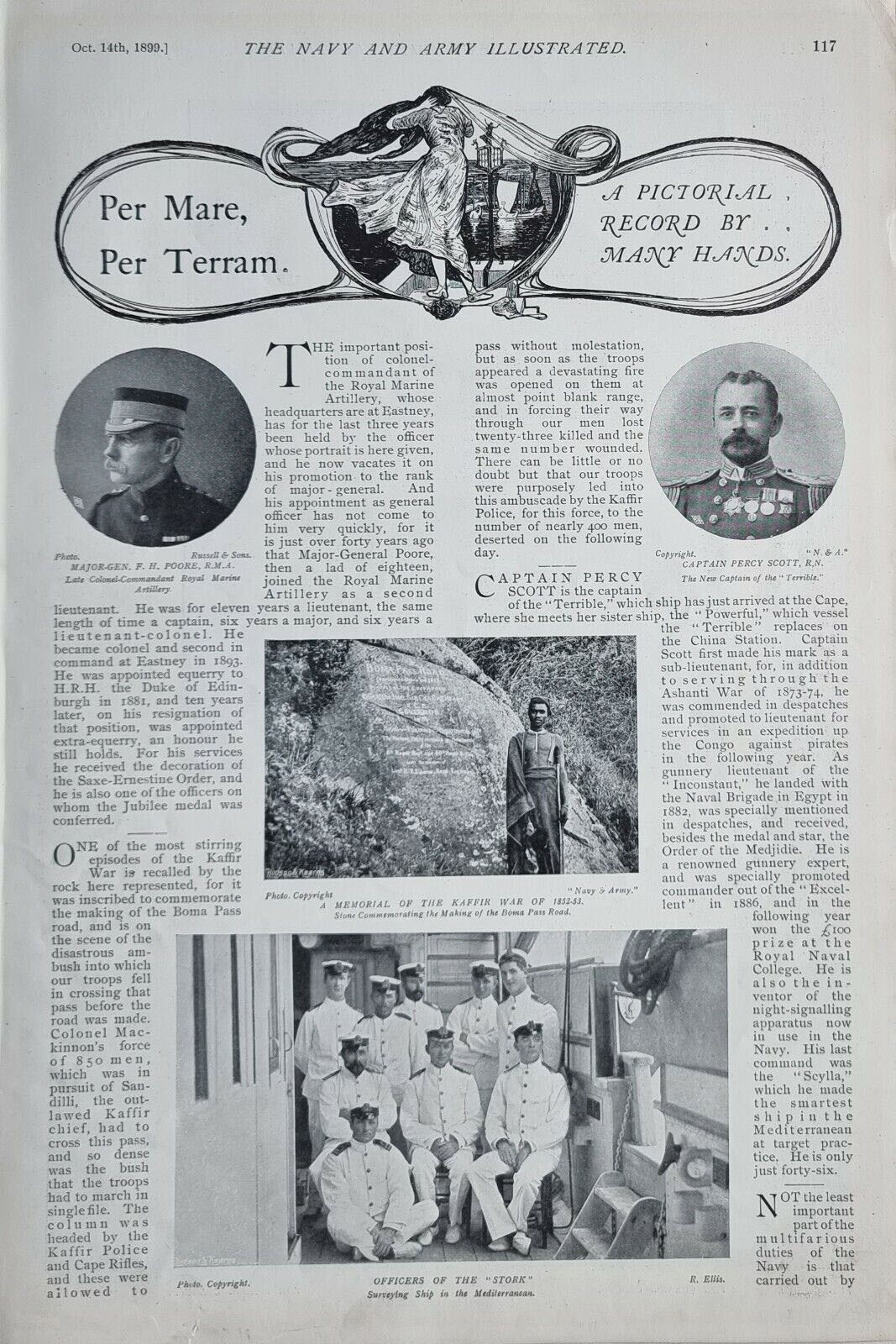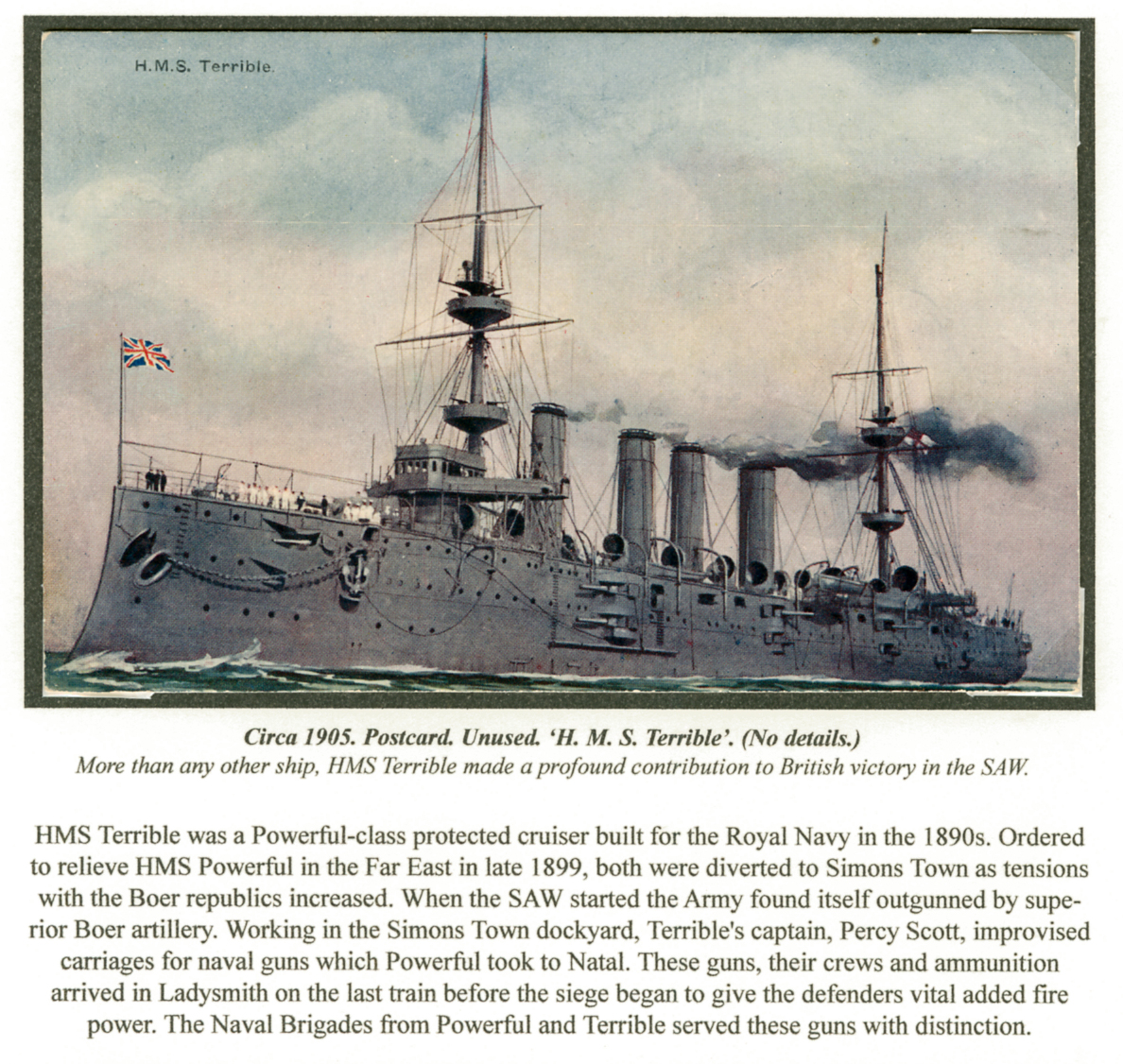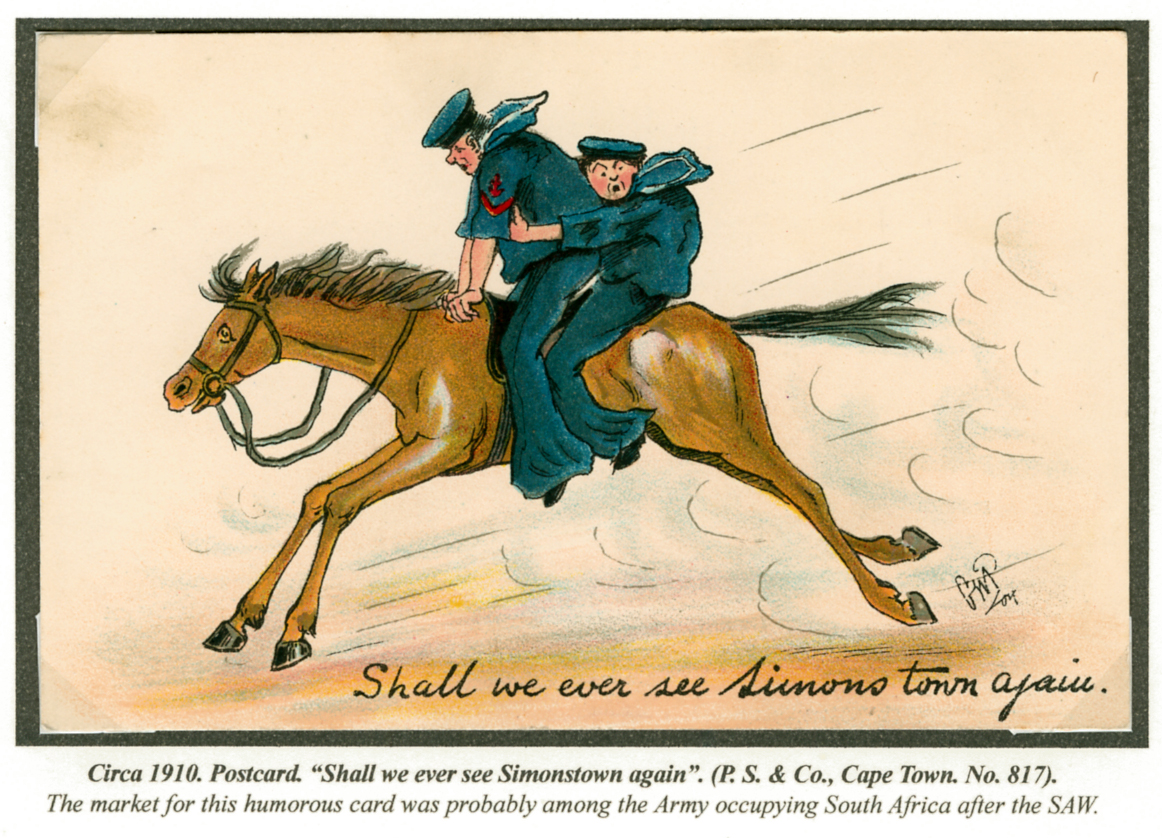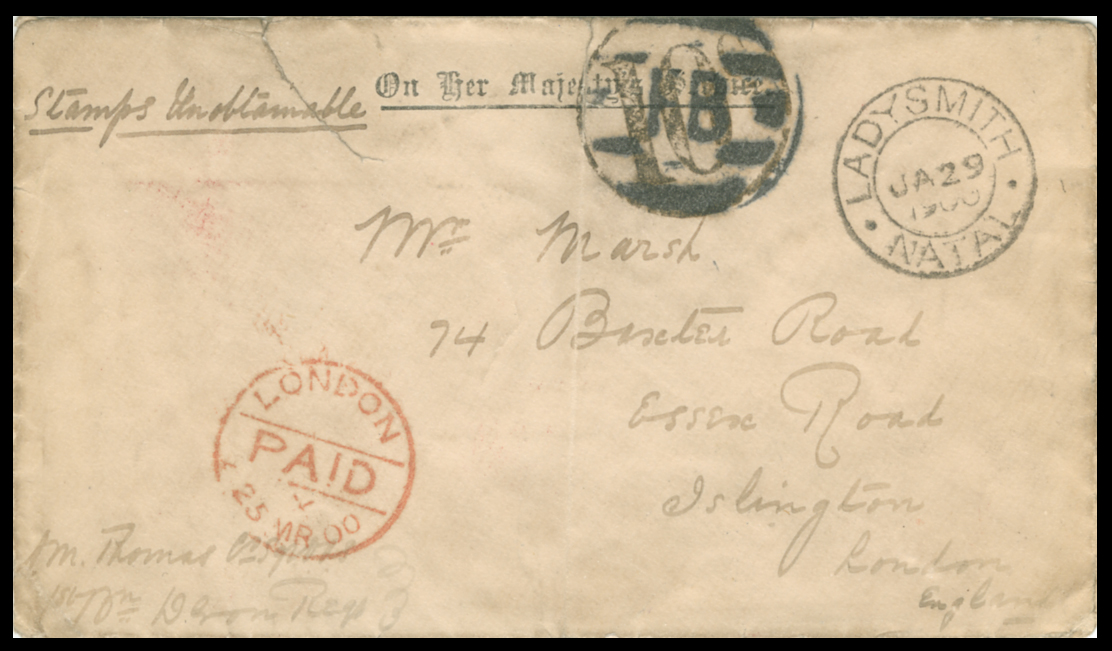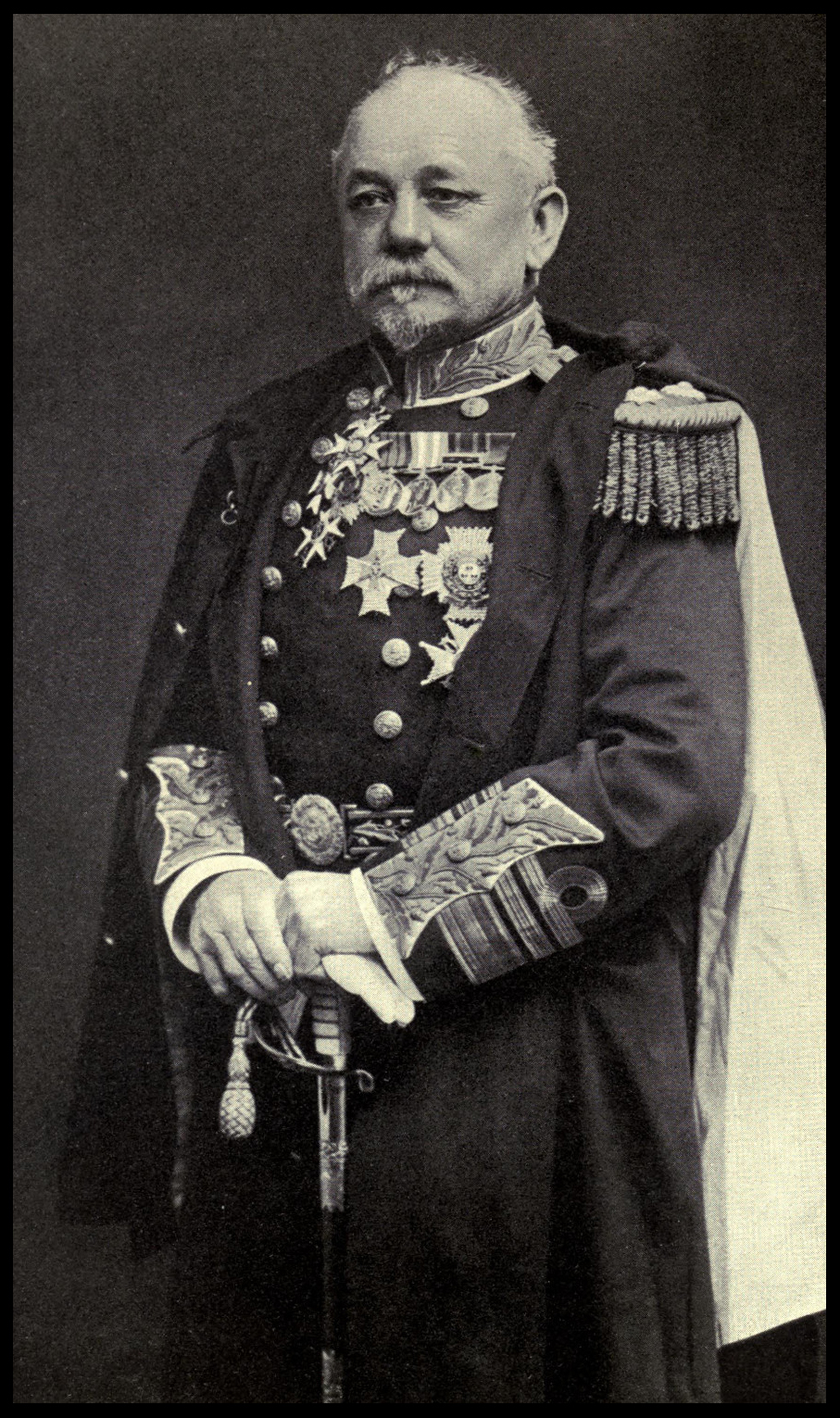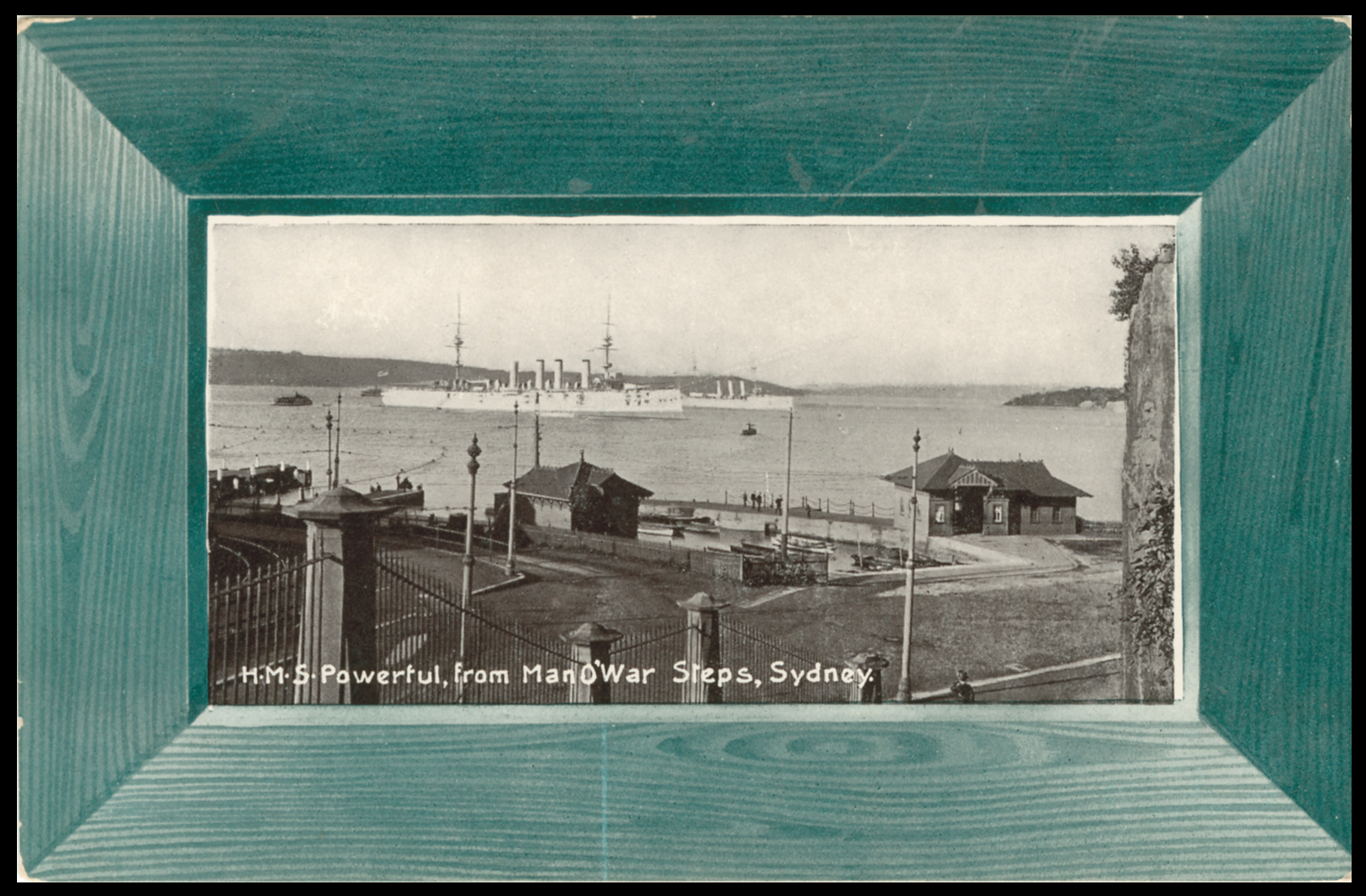Captain Percy Scott of the "Terrible".
Quote from Steve on October 10, 2022, 1:00 pmI can across this original single page sheet (as pictured below) on the internet while researching another aspect of the SAW (South African War). The sheet has been taken from 'The NAVY and ARMY ILLUSTRATED' (Volume IX - published in 1899). It is dated three days after the start of the war on the 11th October 1899 and describes Captain Percy Scott as the new master of the "Terrible".
You may have heard about Captain Scott. Most South African postal historians with an interest in the South African War will know that at the start of the SAW he removed naval guns from ships like his own 'Terrible' and placed them on gun carriages of his own design made in the Royal Navy's engineering workship in Simonstown. These were shipped at full speed to Durban. Two guns with several hundred rounds of ammunition made it into Ladysmith on the last train to get there before the Boer noose tightened and the siege began.
Scott's innovation arguably saved the British Army from annihilation in Natal where it was out-gunned by heavier Boer artillery. Further, it was no fluke that he was able to convert naval guns to heavy field artillery within days of being ordered to do so. He had prepared for this eventuality some days in advance of the order. He did not do it brilliantly overnight as some suggest. He had reckoned that when war was declared the British Army would be in for an unfair pounding. As a result, he began unauthorised work on building gun carriages capable of holding heavy naval guns. When the order came, he was ready.
What is special for me is that in describing Percy Scott RN, Captain of the "Terrible", the publication has absolutely no idea that he was soon to become arguably the most important and influential British officer in the history of the conflict in South Africa. It is not unfair to say that this Royal Naval officer saved the British Army from extinction in the early stages of the war in Natal.
Below are a few items to embellish this post - a postcard of HMS Terrible and one of the sailors of the Naval Brigade who manned the naval guns used by the Army in the veld. Generally, the Army admired the men of the Naval Brigade. This humorous card was presumably sold once the war was over and inter-service rivalries restarted in jest. The last is a nice cover from Ladysmith from just after the siege was lifted. It was officiously taxed on arrival in the UK and then cancelled, probably on account of the powerful and emotive 'LADYSMITH' postmark and the 'Stamps Unobtainable'.
I can across this original single page sheet (as pictured below) on the internet while researching another aspect of the SAW (South African War). The sheet has been taken from 'The NAVY and ARMY ILLUSTRATED' (Volume IX - published in 1899). It is dated three days after the start of the war on the 11th October 1899 and describes Captain Percy Scott as the new master of the "Terrible".
You may have heard about Captain Scott. Most South African postal historians with an interest in the South African War will know that at the start of the SAW he removed naval guns from ships like his own 'Terrible' and placed them on gun carriages of his own design made in the Royal Navy's engineering workship in Simonstown. These were shipped at full speed to Durban. Two guns with several hundred rounds of ammunition made it into Ladysmith on the last train to get there before the Boer noose tightened and the siege began.
Scott's innovation arguably saved the British Army from annihilation in Natal where it was out-gunned by heavier Boer artillery. Further, it was no fluke that he was able to convert naval guns to heavy field artillery within days of being ordered to do so. He had prepared for this eventuality some days in advance of the order. He did not do it brilliantly overnight as some suggest. He had reckoned that when war was declared the British Army would be in for an unfair pounding. As a result, he began unauthorised work on building gun carriages capable of holding heavy naval guns. When the order came, he was ready.
What is special for me is that in describing Percy Scott RN, Captain of the "Terrible", the publication has absolutely no idea that he was soon to become arguably the most important and influential British officer in the history of the conflict in South Africa. It is not unfair to say that this Royal Naval officer saved the British Army from extinction in the early stages of the war in Natal.
Below are a few items to embellish this post - a postcard of HMS Terrible and one of the sailors of the Naval Brigade who manned the naval guns used by the Army in the veld. Generally, the Army admired the men of the Naval Brigade. This humorous card was presumably sold once the war was over and inter-service rivalries restarted in jest. The last is a nice cover from Ladysmith from just after the siege was lifted. It was officiously taxed on arrival in the UK and then cancelled, probably on account of the powerful and emotive 'LADYSMITH' postmark and the 'Stamps Unobtainable'.
Uploaded files:
Quote from Jamie Smith on October 10, 2022, 5:06 pmEnjoyed this posting, thanks, wish a few more would join us!
Enjoyed this posting, thanks, wish a few more would join us!
Quote from Steve on October 11, 2022, 11:56 amActually I was wrong about the Ladysmith cover. I said "The last is a nice cover from Ladysmith from just after the siege was lifted. It was officiously taxed on arrival in the UK and then cancelled, probably on account of the powerful and emotive 'LADYSMITH' postmark and the 'Stamps Unobtainable'".
Sir George White’s troops were besieged in Ladysmith by the invading Boers from the 2nd November 1899 to the 28th February 1900 . This letter was posted one month BEFORE Ladysmith was relieved. It is a very nice and rather scarce example of Ladysmith Siege Mail from a soldier serving in the 1st Battalion The Devonshire Regiment.
Ralph Putzel shows but does not list a Ladysmith Siege 5c To Pay (?) handstamp on page 197 of Vol. 5. This one appears to be a 10c. I am also curious about the barred circular handstamp with PB that appears to cancel it. Usually Pietermaritzburg is spelt 'PMB'. I guess that the Siege Camp Post Office taxed unstamped mail if and when it got mail out during the siege. This 'PB' tax was then cancelled elsewhere, most likely in PB / Pietermaritzburg or London.
Can anyone help with this?
Actually I was wrong about the Ladysmith cover. I said "The last is a nice cover from Ladysmith from just after the siege was lifted. It was officiously taxed on arrival in the UK and then cancelled, probably on account of the powerful and emotive 'LADYSMITH' postmark and the 'Stamps Unobtainable'".
Sir George White’s troops were besieged in Ladysmith by the invading Boers from the 2nd November 1899 to the 28th February 1900 . This letter was posted one month BEFORE Ladysmith was relieved. It is a very nice and rather scarce example of Ladysmith Siege Mail from a soldier serving in the 1st Battalion The Devonshire Regiment.
Ralph Putzel shows but does not list a Ladysmith Siege 5c To Pay (?) handstamp on page 197 of Vol. 5. This one appears to be a 10c. I am also curious about the barred circular handstamp with PB that appears to cancel it. Usually Pietermaritzburg is spelt 'PMB'. I guess that the Siege Camp Post Office taxed unstamped mail if and when it got mail out during the siege. This 'PB' tax was then cancelled elsewhere, most likely in PB / Pietermaritzburg or London.
Can anyone help with this?
Quote from Steve on October 13, 2022, 3:43 pmAnd I was wrong again. This is nothing but a learning curve. Lesson 1. Don't engage mouth before brain.
Okay, the 'PB' mark is most likely an 'FB' mark. A close examination with a powerful printer's magnifier shows it is 'FB' which usually stands for 'Foreign Branch'. The barred 'FB' is most likely a UK mark. The 10c Due amount was cancelled with it as military personnel were exempt from paying postage. This possibly harks from the time when the GPO in GB was receiving a lot of Soldiers' mail from South Africa, much of which was stampless due to a shortage of stamps and the circumstances on the battlefields at this time ie, various sieges and defeats. Does the fact that this went to the Foreign Branch indicate that someone was passing the buck upwards for a decision on what to do with stampless Soldiers' mail? If true, it was successful. The answer came back to cancel tax on unstamped Soldier's mail. It was not a Vote winner to continue to tax the families of British Heroes fighting in South Africa like this.
Putzel does not record unnamed Postage Due marks. This is something for the specialist. If you are such, we welcome your advice. Thanks.
And I was wrong again. This is nothing but a learning curve. Lesson 1. Don't engage mouth before brain.
Okay, the 'PB' mark is most likely an 'FB' mark. A close examination with a powerful printer's magnifier shows it is 'FB' which usually stands for 'Foreign Branch'. The barred 'FB' is most likely a UK mark. The 10c Due amount was cancelled with it as military personnel were exempt from paying postage. This possibly harks from the time when the GPO in GB was receiving a lot of Soldiers' mail from South Africa, much of which was stampless due to a shortage of stamps and the circumstances on the battlefields at this time ie, various sieges and defeats. Does the fact that this went to the Foreign Branch indicate that someone was passing the buck upwards for a decision on what to do with stampless Soldiers' mail? If true, it was successful. The answer came back to cancel tax on unstamped Soldier's mail. It was not a Vote winner to continue to tax the families of British Heroes fighting in South Africa like this.
Putzel does not record unnamed Postage Due marks. This is something for the specialist. If you are such, we welcome your advice. Thanks.
Quote from Steve on October 22, 2022, 3:26 pmHere's a bit more about the most influential seaman in the South African War, Captain Percy Scott.
If you doubt the accuracy of that statement consider that nine years after the war had ended General Louis Botha, the ex-Boer General now Prime Minister of the Union of South Africa, said that "but for these guns I would have flown the Vierkleur over the Town Hall at Durban". Scott agrees that Botha certainly could have done so, for the Boers were south of the Tugela in possession of the railway, moving rapidly, and we had no army in Natal.
I have taken the following from 'FIFTY YEARS IN THE ROYAL NAVY' by Admiral Sir Percy Scott, BT., K.C.B., K.C.V.O., HON. LL.D. CAM. (John Murray, Albemarle Street, W. London 1919).
THE 4.7-IN. GUN AT LADYSMITH
Scott picks up the tale with the mounting of two 4.7" guns on carriages bound for Ladysmith. "The Dockyard worked well, and by 4 p.m. both mountings were ready. Some "know-alls" were quite certain that the platforms would require concreting down. I was certain they would not, but as I had not time to demonstrate this I took the precaution of sending with the mountings sixteen old 12-inch 600-lb. shot, and some chain, with which to anchor down, if necessary, the ends of the timbers." Scott wanted to more ammunition with the guns but he was over-ruled.
Powerful left Simonstown (with two 4.-inch guns and two 12-pounders) under full speed for Durban, "where the guns were entrained for Ladysmith. Immediately on arrival the 12-pounders were brought into action. They opened fire at 7000 yards on the Boer artillery, and kept it in check while Sir George White was withdrawing his own guns into the town. In this initial action, the Gunnery Lieutenant of the Powerful, to whom I had given the instructions for mounting the 4.7-inch guns, was unfortunately killed, and the mounting of the guns fell into the hands of some one else, who unfortunately concreted them in, thereby destroying their mobility. This mistake may have been due to the following telegram sent by Admiral Sir Robert Harris: "I am sending in Powerful, due at Durban on the 29th, two 4.7-inch guns, on extemporised mountings. Efficient SOLID PLATFORM accommodation should be ready for them.""
Nine years afterwards Scott was back in South Africa meeting Botha and also visiting Ladysmith where "the Mayor told me that no one had ever been able to solve the mystery of how these 12-inch shot got to Ladysmith."
"The day after the Powerful left we had another mounting ready, and for the benefit of the wiseacres who had doubted its stability and thought a solid platform necessary, I fired the gun without sinking the platform into the earth at all, with the result that the platform did no more than jump slightly. To test how long it took to dismantle the mounting and take it to another position, we fired a round in one position and in half an hour had the gun ready for firing in another position 100 yards away, thus demonstrating that the mounting fulfilled the conditions of mobility. A great number of these mountings were used during the late war".
"After the relief of Ladysmith, when the shortage of ammunition for the two 4.7-inch guns became generally known, a newspaper stated that I was responsible for the limited amount of ammunition sent into Ladysmith. I will make it quite clear now that I was in no way responsible for the shortage, that I used every endeavour to get more ammunition for them, and that had the amount of ammunition which I pressed for gone with the guns, Ladymith would not have suffered as it did from the Boer bombardment".
Sadly, Scott's eldest son died at the Battle of Jutland in a ship not fully-equipped with director-firing, and who had commented to his father only a week before about the poor standard of their gunnery - the very thing Admiral Scott had spent most of his career trying to improve.
The images below show:
1]. Admiral Percy Scott BT., K.C.B., K.C.V.O., HON. LL.D. CAM. in the full pomp of a dress uniform.
2]. HMS Powerful, the ship that rushed the guns to Durban, at anchor in Sydney, NSW, Australia.
Here's a bit more about the most influential seaman in the South African War, Captain Percy Scott.
If you doubt the accuracy of that statement consider that nine years after the war had ended General Louis Botha, the ex-Boer General now Prime Minister of the Union of South Africa, said that "but for these guns I would have flown the Vierkleur over the Town Hall at Durban". Scott agrees that Botha certainly could have done so, for the Boers were south of the Tugela in possession of the railway, moving rapidly, and we had no army in Natal.
I have taken the following from 'FIFTY YEARS IN THE ROYAL NAVY' by Admiral Sir Percy Scott, BT., K.C.B., K.C.V.O., HON. LL.D. CAM. (John Murray, Albemarle Street, W. London 1919).
THE 4.7-IN. GUN AT LADYSMITH
Scott picks up the tale with the mounting of two 4.7" guns on carriages bound for Ladysmith. "The Dockyard worked well, and by 4 p.m. both mountings were ready. Some "know-alls" were quite certain that the platforms would require concreting down. I was certain they would not, but as I had not time to demonstrate this I took the precaution of sending with the mountings sixteen old 12-inch 600-lb. shot, and some chain, with which to anchor down, if necessary, the ends of the timbers." Scott wanted to more ammunition with the guns but he was over-ruled.
Powerful left Simonstown (with two 4.-inch guns and two 12-pounders) under full speed for Durban, "where the guns were entrained for Ladysmith. Immediately on arrival the 12-pounders were brought into action. They opened fire at 7000 yards on the Boer artillery, and kept it in check while Sir George White was withdrawing his own guns into the town. In this initial action, the Gunnery Lieutenant of the Powerful, to whom I had given the instructions for mounting the 4.7-inch guns, was unfortunately killed, and the mounting of the guns fell into the hands of some one else, who unfortunately concreted them in, thereby destroying their mobility. This mistake may have been due to the following telegram sent by Admiral Sir Robert Harris: "I am sending in Powerful, due at Durban on the 29th, two 4.7-inch guns, on extemporised mountings. Efficient SOLID PLATFORM accommodation should be ready for them.""
Nine years afterwards Scott was back in South Africa meeting Botha and also visiting Ladysmith where "the Mayor told me that no one had ever been able to solve the mystery of how these 12-inch shot got to Ladysmith."
"The day after the Powerful left we had another mounting ready, and for the benefit of the wiseacres who had doubted its stability and thought a solid platform necessary, I fired the gun without sinking the platform into the earth at all, with the result that the platform did no more than jump slightly. To test how long it took to dismantle the mounting and take it to another position, we fired a round in one position and in half an hour had the gun ready for firing in another position 100 yards away, thus demonstrating that the mounting fulfilled the conditions of mobility. A great number of these mountings were used during the late war".
"After the relief of Ladysmith, when the shortage of ammunition for the two 4.7-inch guns became generally known, a newspaper stated that I was responsible for the limited amount of ammunition sent into Ladysmith. I will make it quite clear now that I was in no way responsible for the shortage, that I used every endeavour to get more ammunition for them, and that had the amount of ammunition which I pressed for gone with the guns, Ladymith would not have suffered as it did from the Boer bombardment".
Sadly, Scott's eldest son died at the Battle of Jutland in a ship not fully-equipped with director-firing, and who had commented to his father only a week before about the poor standard of their gunnery - the very thing Admiral Scott had spent most of his career trying to improve.
The images below show:
1]. Admiral Percy Scott BT., K.C.B., K.C.V.O., HON. LL.D. CAM. in the full pomp of a dress uniform.
2]. HMS Powerful, the ship that rushed the guns to Durban, at anchor in Sydney, NSW, Australia.

